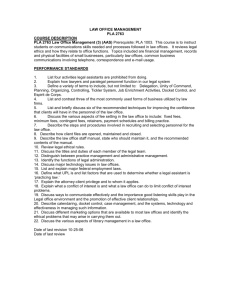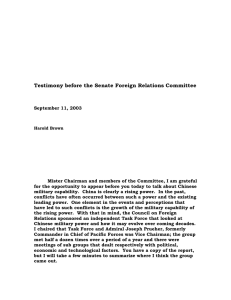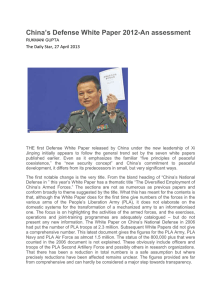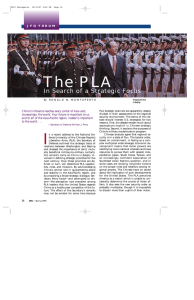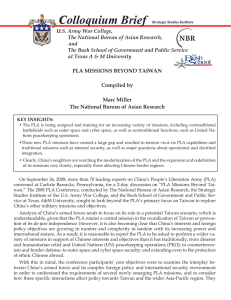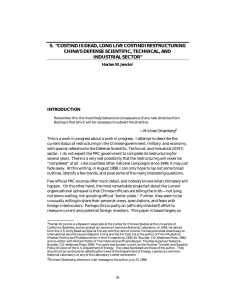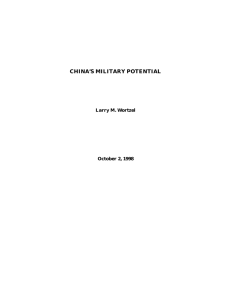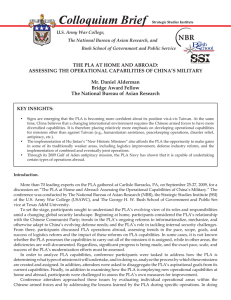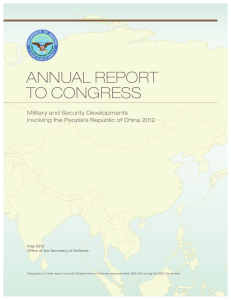Statement of the Richard P. Lawless
advertisement
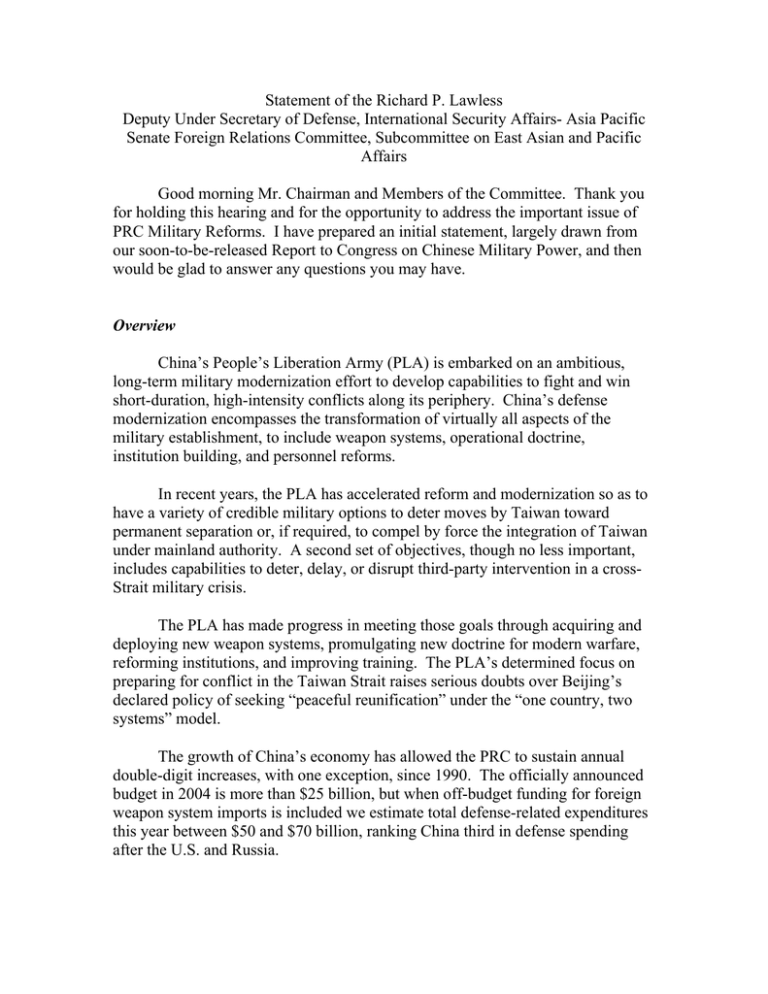
Statement of the Richard P. Lawless Deputy Under Secretary of Defense, International Security Affairs- Asia Pacific Senate Foreign Relations Committee, Subcommittee on East Asian and Pacific Affairs Good morning Mr. Chairman and Members of the Committee. Thank you for holding this hearing and for the opportunity to address the important issue of PRC Military Reforms. I have prepared an initial statement, largely drawn from our soon-to-be-released Report to Congress on Chinese Military Power, and then would be glad to answer any questions you may have. Overview China’s People’s Liberation Army (PLA) is embarked on an ambitious, long-term military modernization effort to develop capabilities to fight and win short-duration, high-intensity conflicts along its periphery. China’s defense modernization encompasses the transformation of virtually all aspects of the military establishment, to include weapon systems, operational doctrine, institution building, and personnel reforms. In recent years, the PLA has accelerated reform and modernization so as to have a variety of credible military options to deter moves by Taiwan toward permanent separation or, if required, to compel by force the integration of Taiwan under mainland authority. A second set of objectives, though no less important, includes capabilities to deter, delay, or disrupt third-party intervention in a crossStrait military crisis. The PLA has made progress in meeting those goals through acquiring and deploying new weapon systems, promulgating new doctrine for modern warfare, reforming institutions, and improving training. The PLA’s determined focus on preparing for conflict in the Taiwan Strait raises serious doubts over Beijing’s declared policy of seeking “peaceful reunification” under the “one country, two systems” model. The growth of China’s economy has allowed the PRC to sustain annual double-digit increases, with one exception, since 1990. The officially announced budget in 2004 is more than $25 billion, but when off-budget funding for foreign weapon system imports is included we estimate total defense-related expenditures this year between $50 and $70 billion, ranking China third in defense spending after the U.S. and Russia. China’s military reform has also benefited from observing U.S. operations. The PLA first observed the Revolution in Military Affairs from the 1991 Operation DESERT STORM and studied how a technologically inferior force could defend against a superior opponent during Operation ALLIED FORCE over Kosovo. The PLA has likewise studied Operations ENDURING FREEDOM and IRAQI FREEDOM. The PLA likely learned lessons on the application of unmanned aerial vehicles for reconnaissance and strike operations, the role of modern, well-trained Special Forces in precision targeting, and the importance of speed in modern warfare. There are several key areas of reform which I’d like to emphasize. Joint Operations PLA theorists and planners believe that future campaigns will be conducted simultaneously on land, at sea, and in the air, space, and the electronic sphere. Therefore, the PLA is improving its joint operations capabilities by developing an integrated C4ISR network, a new command structure, and a joint logistics system. Air Operations The PLA Air Force (PLAAF) is transitioning from a defensive force to one with a modern, offensive strike capability. China’s force modernization plan and acquisition strategy for its air forces have been aimed mainly at defeating regional air forces, defending against aircraft operating at long ranges from China’s coast, denying US naval operations, and striking regional targets such as airbases and air defense sites. Conventional Missile Operations Beijing’s growing conventional missile force provides a strategic capability without the political and practical constraints associated with nuclear-armed missiles. The PLA’s short-range ballistic missiles (SRBMs) provide a survivable and effective conventional strike force and represent a real-time coercive option. China continues to improve quantitatively and qualitatively the capabilities of its conventionally armed SRBM force. The deployed inventory number are 500-550 SRBMs, all deployed opposite Taiwan, and are increasing at a rate of 75 a year. The accuracy and lethality of this force also are expected to increase through use of satellite-aided guidance systems. Naval Operations Beijing realizes it must have forces available to respond rapidly to a range of regional contingencies, and it is seeking to build a balanced naval force for surface, antisubmarine, submarine, air defense, mine, and amphibious warfare. C4ISR China requires a survivable, robust, reliable, and sophisticated Command, Control, Communications, Computers, Intelligence, Surveillance and Reconnaissance (C4ISR) system to harness battlespace information. The PLA continues to upgrade its communication capabilities, which eventually will rival the most modern civil networks. Space Acquiring modern ISR systems remains critical to Beijing's military modernization program and supports the PLA’s local wars doctrine. Ongoing space-based systems with potential military applications include two new remotesensing satellites; advanced imagery, reconnaissance, and Earth resource systems with military applications; and electronic intelligence (ELINT) or signals intelligence (SIGINT) reconnaissance satellites. China is conducting extensive studies and is seeking foreign assistance on small satellites and microsatellitesweighing less than 100 kilogramsfor missions that include remote sensing and networks of electro-optical and radar satellites. Counterspace Developments China is expected to continue to enhance its satellite tracking and identification network. According to press accounts, China can use probable lowenergy lasers to “blind” the sensors on low-Earth-orbiting satellites, although whether this claim extends to actual facilities is unclear. China has reportedly begun testing an anti-satellite (ASAT) system. China’s Defense Industrial Base Finally, let me conclude with some brief remarks about China’s defense industry. China’s defense industrial base -- also known as National Defense Science, Technology, and Industry (NDST&I) -- is a redundant structure, consisting of the factories, institutes, and academies subordinate to the organizations that represent the nuclear, aeronautics, electronics, ordnance, shipbuilding, and astronautics industries. The production factories are represented, for import/export purposes, by trading corporations with well known names such as China Aero-Technology Import/Export Corporation (CATIC) and China North Industries Corporation (NORINCO.) The import/export corporations are entities which aggressively pursue contracts to sell PRC equipment overseas as well as involve foreign companies in joint ventures in China. These corporations are closely monitored by the State Department for proliferation concerns. For example, CATIC was sanctioned as recently as May 2002 pursuant to the Iran Nonproliferation Act. Mr. Chairman, this concludes my testimony. I would be glad to answer any questions you have.

